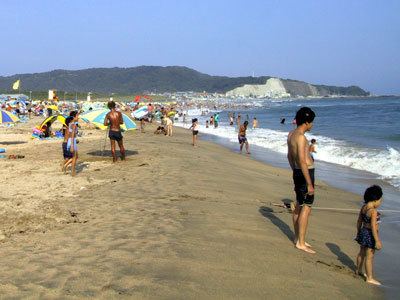Phone number 0470-68-2511 Population 7,429 (1 Dec 2015) | Region Kanto - Tree Oleander Area 24.86 km² Local time Saturday 12:16 PM | |
 | ||
Weather 10°C, Wind NE at 14 km/h, 52% Humidity | ||
The original urban gardens of chiba onjuku boso japan
Onjuku (御宿町, Onjuku-machi) is a town located in Isumi District, Chiba, Japan. As of December 1, 2015, the town had an estimated population of 7,429 and a population density of 299 persons per km². The total area was 24.86 square kilometres (9.60 sq mi). The name of the town is made of two kanji, the first meaning “honorable”, and the second meaning “residence”.
Contents
- The original urban gardens of chiba onjuku boso japan
- Map of Onjuku Isumi District Chiba Prefecture Japan
- Geography
- Surrounding municipalities
- Early History
- Edo Period
- Landing of Rodrigo de Vivero
- Current Administration
- Economy
- Education
- Sports
- Railway
- Highway
- Sister city relations
- References
Map of Onjuku, Isumi District, Chiba Prefecture, Japan
Geography
Onjuku is located on the east coast of southern Chiba Prefecture in approximately the center of the outer coast of the Bōsō Peninsula. The landscape consists of rolling, sandy hills of the Bōsō Hill Range, and the town is noted for its beach resorts. Its broad beaches are protected as part of the Minami Bōsō Quasi-National Park.
Onjuku is bordered by the Pacific Ocean to the east, and enjoys a temperate maritime climate, with short, cool winters and hot, humid summers due to the effects of the Kuroshio Current offshore. Onjuku faces Ajiro Bay, which has two functional ports: the Port of Iwawada to the north, and the Port of Onjuku to the south. One small river, the Kiyomizu River, flows through the town to Ajiro Bay.
Surrounding municipalities
Chiba Prefecture
Early History
Onjuku is part of ancient Kazusa Province. The pines and sand of Ajiro Bay in Onjuku were referenced in a poem by Hōjō Tokiyori (1227–1263), a Kamakura-period administrator.
Edo Period
Onjuku, from the Muromachi to the Edo period, was divided into a complex mixture of administrative areas. Much of the town was tenryō territory ruled by various hatamoto on behalf of the Shogun. The town was typically associated with administrators from the Ōtaki and Iwatsuki domains. In the Edo period a prominent “rokusai’ichi” (六斎市) market, or open-air market held on fixed days six times a month, developed in Onjuku.
Landing of Rodrigo de Vivero
In 1609 a Spanish galleon, the San Francisco, ran aground near Onjuku. The captain and 300 survivors were cared for by the town, and later, the sailors were given a ship by the Tokugawa Shogunate to return to Mexico. One of the survivors was Governor General of the Philippines Rodrigo de Vivero, who was subsequently granted an audience with Shogun Tokugawa Ieyasu.
In 1928 a tower was built in Onjuku to commemorate the landing of Rodrigo and friendly relations between Mexico, Spain, and Japan. It has since been designated an Important Prefectural Monument (県指定史跡 (ken shitei shiseki)), and is surrounded by an extensive garden complex.
Current Administration
The village of Onjuku was created on April 1, 1889 with the early Meiji period establishment of the municipalities system, and was elevated to town status on April 1, 1914. The town expanded through annexation of areas of the neighboring villages of Fuse and Namihana on March 1, 1955.
Economy
The economy of Onjuku is dominated by summer tourism and commercial fishing; agriculture plays a relatively small role in the economy compared to nearby municipalities. Commercial coastal and off-shore fishing operations are active, with squid and bonito being the most important catches. Ama, or traditional women divers, gather abalone, turban shell (sazae), and spiny lobster, all important parts of the traditional Japanese diet.
The sandy beaches of Onjuku are the representative swimming areas of the Sotobōsō Coast and attract numerous tourists during the summer months. Tourism in the town began in the Meiji period, and development of the tourism industry continues. Numerous guests houses, ryokan (traditional Japanese inns), and hotels have developed in the area.
Education
Onjuku has two elementary schools and one middle school, but no high school.
Sports
Due to the infrastructure and sandy beach with good surf conditions, the locality holds the yearly national surf carnival of the Japan Lifesaving Association, in which surf lifesavers gather from all clubs over the country. In 2013, the worldwide 2013 International Surf Rescue Challenge is held here.
